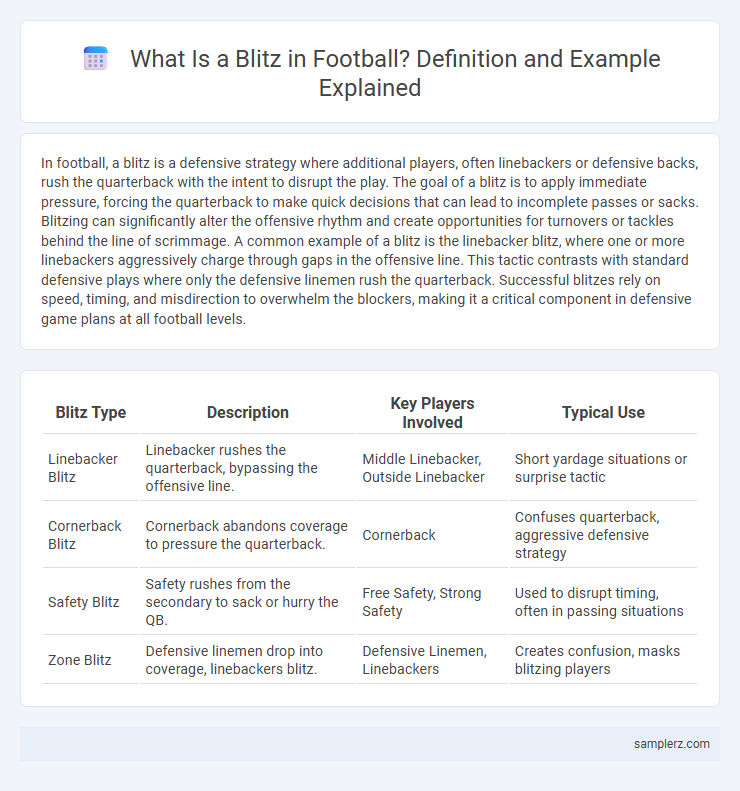In football, a blitz is a defensive strategy where additional players, often linebackers or defensive backs, rush the quarterback with the intent to disrupt the play. The goal of a blitz is to apply immediate pressure, forcing the quarterback to make quick decisions that can lead to incomplete passes or sacks. Blitzing can significantly alter the offensive rhythm and create opportunities for turnovers or tackles behind the line of scrimmage. A common example of a blitz is the linebacker blitz, where one or more linebackers aggressively charge through gaps in the offensive line. This tactic contrasts with standard defensive plays where only the defensive linemen rush the quarterback. Successful blitzes rely on speed, timing, and misdirection to overwhelm the blockers, making it a critical component in defensive game plans at all football levels.
Table of Comparison
| Blitz Type | Description | Key Players Involved | Typical Use |
|---|---|---|---|
| Linebacker Blitz | Linebacker rushes the quarterback, bypassing the offensive line. | Middle Linebacker, Outside Linebacker | Short yardage situations or surprise tactic |
| Cornerback Blitz | Cornerback abandons coverage to pressure the quarterback. | Cornerback | Confuses quarterback, aggressive defensive strategy |
| Safety Blitz | Safety rushes from the secondary to sack or hurry the QB. | Free Safety, Strong Safety | Used to disrupt timing, often in passing situations |
| Zone Blitz | Defensive linemen drop into coverage, linebackers blitz. | Defensive Linemen, Linebackers | Creates confusion, masks blitzing players |
Understanding the Concept of a Blitz in Football
A blitz in football occurs when the defense sends extra players, often linebackers or defensive backs, to rush the quarterback beyond the standard defensive line pressure. This aggressive tactic aims to disrupt the quarterback's timing and force hurried decisions, increasing the chances of a sack or turnover. Successful blitzes rely on precise coordination and timing to outmaneuver the offensive line and coverage assignments.
Historical Evolution of the Blitz Strategy
The blitz strategy in football originated in the early 20th century as defenses sought aggressive tactics to disrupt offensive plays, with the Chicago Bears pioneering early forms in the 1940s. Over decades, coaches like Buddy Ryan innovated the concealing and timing of blitzes, leading to more complex schemes involving multiple defenders targeting the quarterback. Modern football continuously adapts blitz techniques through film study and analytics, refining pressure methods to counter sophisticated passing offenses.
Classic Blitz Formation Examples
Classic blitz formation examples in football often feature the 4-3 defense, where three linebackers aggressively rush the quarterback to disrupt the offensive play. Another well-known example is the 3-4 defense blitz, utilizing four linebackers to create confusion and pressure, maximizing pass rush potential. These formations emphasize speed and timing to overwhelm offensive linemen and create sacks or hurried throws.
Linebacker Blitz: A Game-Changing Tactic
A linebacker blitz in football is a strategic defensive move where the linebacker aggressively rushes the quarterback to disrupt a passing play. This tactic forces the quarterback to make quicker decisions, increasing the chance of sacks or hurried throws that can lead to turnovers. Teams often use linebacker blitzes to create pressure without sacrificing secondary coverage, making it a game-changing element in defensive schemes.
Safety Blitz: Risks and Rewards
A Safety Blitz involves the safety rushing the quarterback, creating unexpected pressure and disrupting passing plays. This aggressive tactic increases the risk of leaving deep field zones vulnerable to long completions or big plays by the offense. Teams must balance the potential for sacks or hurried throws against the possibility of conceding significant yardage on such blitzes.
Cornerback Blitz: Surprise Element on Defense
A cornerback blitz in football is a defensive strategy where the cornerback rushes the quarterback, creating an unexpected pressure point that disrupts offensive plays. This tactic is effective because cornerbacks typically cover receivers, so their sudden involvement in the pass rush can confuse the quarterback and offensive line. Executing a cornerback blitz requires precise timing and coordination, making it a valuable surprise element in defensive schemes.
Famous Blitz Plays in NFL History
The "Nickel Blitz" by the 1985 Chicago Bears showcased a devastating pass rush that overwhelmed quarterbacks with coordinated linebacker and defensive back pressure. The New York Giants' "Eli Blitz" in Super Bowl XLII cleverly disguised a linebacker blitz, contributing to their upset victory over the previously undefeated Patriots. The Pittsburgh Steelers' "L.C. Blitz," named after coordinator Dick LeBeau, revolutionized defensive scheming by sending unexpected line and linebacker combinations after the quarterback.
Blitzing Against Different Offensive Formations
Blitzing against a shotgun formation requires linebackers to attack gaps quickly, exploiting the quarterback's limited time and forcing hurried throws. In contrast, when facing a I-formation, blitzers often focus on disrupting the running game by penetrating the offensive line and cutting off running lanes. Adjusting blitz tactics based on offensive formations enhances defensive pressure and increases the likelihood of sacks or forced turnovers.
Coaching Tips for Executing Effective Blitzes
Coaches emphasize timing and player discipline to execute effective blitzes in football, ensuring linebackers and defensive backs coordinate shifts and disguise intentions. Key techniques include varied blitz packages and maintaining gap integrity to pressure quarterbacks while minimizing big-play risks. Film analysis of opponent tendencies aids coaching decisions, maximizing blitz success rates during critical game moments.
Common Mistakes When Blitzing and How to Avoid Them
Common mistakes when blitzing in football include overcommitment, which leaves secondary coverage vulnerable, and poor timing that allows quarterbacks to escape pressure. Blitzers often fail to disguise their intentions, making it easier for the offense to adjust blocking schemes. To avoid these errors, defenders should coordinate with the secondary for coverage support, practice precise timing, and use deceptive alignments to confuse the offense.

example of blitz in football Infographic
 samplerz.com
samplerz.com